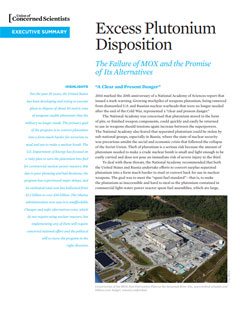Over the last few decades the United States and Russia have dismantled thousands of nuclear weapons, stockpiling dozens of tons of plutonium no longer needed for their nuclear arsenals. Compact, light, and relatively easy to handle, this plutonium poses a serious security risk, as only a few kilograms are need to make a crude nuclear bomb. In 2000, both the United States and Russia agreed to dispose of a significant fraction of their excess plutonium—but so far they haven’t.
Download the Department of Energy's 2006 "Plutonium Disposition Alternatives Analysis"
The United States’ current plan is to blend its plutonium with uranium, making fuel—called mixed-oxide (MOX) fuel—for commercial nuclear power plants. While initially attractive, plans to build a factory for producing MOX led to an extremely costly, mismanaged, and still only partially completed MOX Fuel Fabrication Plant in South Carolina. Originally projected to cost about $1.5 billion (in 2014 dollars), the total program cost is now estimated as at least $30 billion, of which $4 billion has already been spent. The Department of Energy now says it may be “unaffordable” and wants to find a workable alternative, though Congress and South Carolina have fought for its completion.
Importantly, the MOX program has weakened domestic and international standards for securing nuclear materials, as the plutonium is vulnerable to theft during transportation and processing.
Though not simple, finding practical and cost-effective alternatives to MOX is essential for national security. “Immobilizing” plutonium by surrounding it with radioactive waste would help deter theft, lessening security risks. Dilution, or “downblending,” is another option. Once downblended, the plutonium could then be stored underground at a nuclear waste repository, such as New Mexico’s Waste Isolation Pilot Plant.




